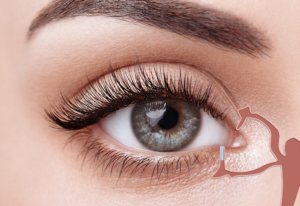Dry Eye Syndrome
There are a variety of causes for Dry Eye Syndrome, including dusty or windy environments, pollutants such as cigarette smoke, excessive use of contact lenses, the natural process of aging, and even the use of certain medications.
Dry Eye Syndrome is a very common condition that causes itching, burning, and/or an inflamed sensation in the eyes. There are a variety of causes for Dry Eye Syndrome, including dusty or windy environments, pollutants such as cigarette smoke, excessive use of contact lenses, the natural process of aging, and even the use of certain medications. These factors can contribute to a decrease in the amount of tears that are created to keep the eyes lubricated.
At New Eyes, our eye care specialists offer medicinal eye drops that can be very effective at reducing the symptoms of dry eye syndrome. There are other safe treatment options, such as punctal occlusion, which can allow the eyes natural lubrication to stay around longer to keep the eyes moist.
Are There Different Types of Dry Eye Syndrome?
Dry Eye Syndrome can occur due to a variety of factors, and identifying the type of Dry Eye Syndrome you have makes it easier to select the ideal course of treatment. Sometimes, dryness happens due to allergens or environmental effects. In other cases, dry eyes may be caused by anatomic issues or other medical concerns. Tears are made up of several substances, including water, sodium, potassium, mucus, and oil. If your eyes have difficulty producing the water component, it is called Aqueous-Deficient Dry Eye. If your eyes struggle to produce the oil, or if they are affected by blocked oil glands, then the disorder is known as Evaporative Dry Eye. Evaporative Dry Eye Syndrome is the more common of the two, representing approximately 86 percent of chronic dry eye sufferers.
What Are the Most Common Symptoms of Dry Eye Syndrome?
Symptoms can range widely for Dry Eye Syndrome, and you may have this concern without realizing it. Some of the most common effects of dry eyes include:
- Stinging, burning, or scratchy sensation in one or both eyes
- Sensitivity to light
- Redness in one or both eyes
- Blurred nighttime vision
- Difficulty putting in or wearing contact lenses
- Eye fatigue
- Watering eyes
If these symptoms occur rarely, they may not be an issue, but routinely experiencing red, irritated, tired, or painful eyes suggests something else could be affecting your vision. Talk to us about your experiences so we can help.
What Are My Dry Eye Treatment Options?
Advances in medical care have provided a range of effective treatments to address Dry Eye Syndrome. To provide long-term relief, it is just as important to treat any underlying cause or causes as well as to alleviate the symptoms. We can evaluate your eyes, medical history, lifestyle, and other factors to help determine if there is a fundamental issue at work.
Eye Drops & Medications
When applicable, eye drops and medications can be used to reduce eyelid and corneal inflammation for individuals suffering from Dry Eye Syndrome. Furthermore, these treatments stimulate natural tear production and can be very effective in improving patient well-being. Sometimes it’s simply a matter of updating the brand of contact lenses you wear. We can help you find the right plan for your needs and goals and guide you toward a solution that offers better and more comfortable vision.
Punctal Plug Procedure
 In the event that eye drops do not adequately address the symptoms of Dry Eye Syndrome, a punctal plug can often be an effective treatment. These tiny devices are gentle and smaller than a grain of rice. They are inserted into the tear duct to block drainage in the eye, therefore helping to relieve dryness. Punctal plugs are made of a biocompatible material, and can be either semi-permanent or temporary. Semi-permanent punctal plugs are generally made of a long-lasting material like silicone, while temporary punctal plugs — which last anywhere from one week to six months — are made of a dissolvable material designed to be naturally absorbed by the body over time. Temporary plugs are commonly used to avoid dry eye as a side effect after another procedure, such as LASIK. Additionally, temporary plugs can sometimes be a good way to determine whether or not a semi-permanent plug may be right for you.
In the event that eye drops do not adequately address the symptoms of Dry Eye Syndrome, a punctal plug can often be an effective treatment. These tiny devices are gentle and smaller than a grain of rice. They are inserted into the tear duct to block drainage in the eye, therefore helping to relieve dryness. Punctal plugs are made of a biocompatible material, and can be either semi-permanent or temporary. Semi-permanent punctal plugs are generally made of a long-lasting material like silicone, while temporary punctal plugs — which last anywhere from one week to six months — are made of a dissolvable material designed to be naturally absorbed by the body over time. Temporary plugs are commonly used to avoid dry eye as a side effect after another procedure, such as LASIK. Additionally, temporary plugs can sometimes be a good way to determine whether or not a semi-permanent plug may be right for you.
Contact New Eyes Las Vegas
If you think you may be affected by Dry Eye Syndrome and would like to see one of our eye care physicians about treatment options, please contact New Eyes to set up an appointment.
